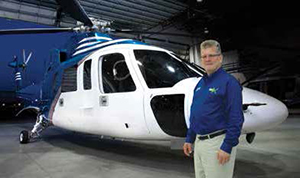
The Drone Invasion?

I need to be honest — to date, I’ve been largely ignoring the idea of drones or unmanned aerial vehicles (UAVs) having any significant impact on the helicopter market.
I chuckled when Amazon announced it was looking into package delivery by drones. I have a hard time wrapping my head around how the company would accomplish that concept safely and effectively. The variety of terrain in and out of a city and the security of a package as it’s being delivered are among the few concerns that I see as major challenges — not to mention the intrusion of these thousands of delivery vehicles on public airspace.
Yet, as I question the timing of the Amazon announcement, I am also witnessing the explosion of the use of drones by many different sectors of the marketplace.
Surveillance is a key component in law enforcement. At the recent Airborne Law Enforcement Association (ALEA) show in Houston, there was no shortage of drone representation. Fitted with cameras and night vision and offering the ability for remote piloting, drones have quickly become a formidable tool for accomplishing what helicopters have been doing, and at a fraction of the cost.
The drone drum beats on for other areas such as monitoring fire progression, delivering badly needed medical supplies or defibrillators to a mountainside, and carrying food and water to flood zones. These are only the tip of the iceberg for possible uses, all while reducing expense and risk associated with the typical helicopter/pilot scenario.
Then there are the aircraft-sized UAVs that can stay airborne as long as and even longer than manned aircraft. Again, things like surveillance or whatever the mind can conceive of are possible scenarios for these vehicles. These are not “futuristic” vehicles by any means. Both drones and UAVs are here and now, as witnessed during my recent trip to Oshkosh, WI, to attend the Experimental Aircraft Association’s (EAA’s) AirVenture 2015.
There is a lot to work out with regards to drones and UAVs. The FAA is currently wrestling with controlling airspace, federal parks are struggling with rules about use of drones in federal lands, studies need to be done to determine safety, drone strike studies need to be conducted, etc. However, all of this doesn’t seem to be hindering the advancement of technology.
What does this mean to the helicopter mechanic and the future of helicopter maintenance?
There is no doubt in my mind that this will have an impact on the need for traditional helicopters. It’s yet to be seen if the new technology will give birth to a whole new need for maintenance or if the need for traditional helicopters will wane.
I am bullish on the future of helicopter maintenance. Unmanned helicopters will need as much or even more maintenance than manned helicopters. There may be many more UAVs than there ever were helicopters. Then there is always drone repair. I’m sure there will eventually be regulatory requirements for inspection and repair of drones.
Think about it. If there are thousands of drones flying around delivering packages, there will be a definite need to minimize the number of them that fall out of the sky on people’s heads.
My recommendation is to embrace technology and you will have a job in helicopter maintenance in the future.
For more information on how drones could affect our industry in the near future, you can read John Pawlicki’s article, “Drone Training Services Open for Business,” in the June issue of our sister publication, D.O.M.magazine. You can find a link to the digital edition of the June issue at www.DOMmagazine.com. You can also read the June issue of D.O.M.magazine in the magazine’s free app for iOS and Android devices.
 As always, thank you for reading.
As always, thank you for reading.
Greg Napert
